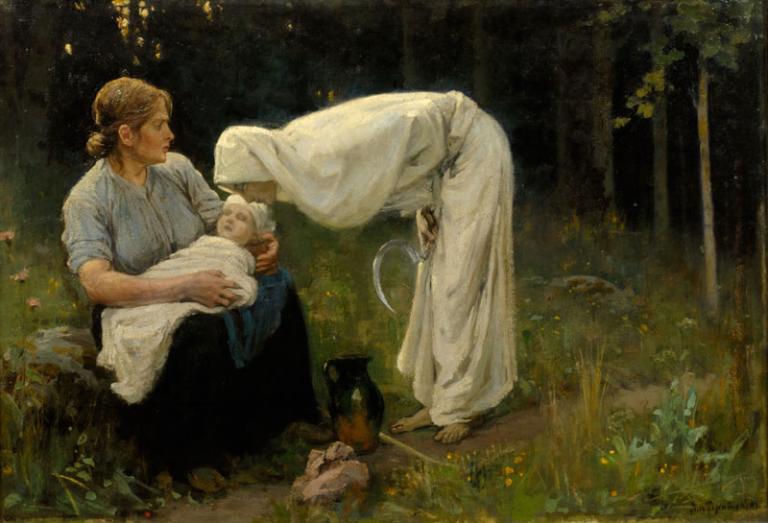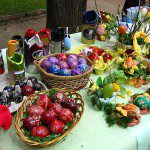I’ll start with the assumption that the Druid path is not necessarily familiar to you. Many people have the image of beardy old guys in white robes, as being your standard Druid, perhaps poncing around at Stonehenge. But it’s a far more diverse and interesting tradition than that. It’s also hard to pin down. Druids can be atheists, agnostics, animists, polytheists and just about anything else you might imagine, including overlapping with all kinds of other traditions.
Where does the poetry come in? What little we know about the ancient Druids includes some information about the role of bards in Celtic societies. Whether or not the bards were part of the Druidic religious path I can’t say, but there is no doubt that they were an important feature of Celtic culture. For someone interested in things Celtic, and a Celt inspired spirituality, the bardic tradition therefore is an appealing one. The romantic image of the windswept wandering bard, harp slung over shoulder, is alluring. There is consensus that poetry was very much the domain of the historical bard.
One thing we can say for certain about all modern Druids is that we do not have a Celtic cultural context to exist in. Whatever we do, we have to fit it into this world, and this time. There are no Kings to appoint chief Bards to their courts. Instead we have publishers, the internet and a host of things our ancient ancestors would never have imagined, and probably wouldn’t have much use for. This is not a barrier to being a modern bard, or Druid, but it means we have to find our own way. There is no defined path supported financially, or otherwise made easy.
Creativity and inspiration are prized by modern Druids, but the form of expression is vast. Any activity can be approached with an artistic mindset and with a desire to be creative and to enhance. Therefore you will find druids working in photography, wood carving, clothes making, film, website design and more. You will also find poets, storytellers, singers, musicians and authors. Some people take their creativity into radical green living, political protest, environmental work and building eco-homes. There is a wonderful diversity out there of people living their creativity.
Modern culture does not go out of its way to encourage creativity. We think of entrepreneurship as being the territory of the already rich and successful, not the person in their garage designing revolutionary technology. Most of us get a lot of encouragement to avoid creativity, buying off the peg solutions and accepting lifestyles that conform to social expectations. Making the transition from a ‘regular’ life to a druidic one, is challenging. No one wakes up one morning, and decides to throw off all the illusions, shackles and habits of thought associated with mainstream society, achieves this by lunchtime and is a full time druid by evening. It doesn’t work that way. Radical life changes and the quest to live fully as a pagan, takes time. Small steps are good.
This another point at which poetry can be a very productive part of the mix. Three lines maketh a haiku. Poems do not have to be big or complex. They can be written in a very short time frame, and don’t even really need narrative or coherence. It takes a lot of organising to set aside time for big acts of creativity. Finding a few minutes to try and pin down a line or three of poetry, is realistic. Anyone can try it.
Taking the time to write a bit of poetry, to seek beauty and inspiration, can help make the transition into a more widely creative life. Knowing that you can manage some poetry opens a door. You may work towards better crafted and more meaningful poetry, or decide to pour your energy somewhere else entirely – it’s all good. The important thing is finding a way to start. A little quick sketching would be just as powerful, or a few minutes of gardening, or listening to music, or singing a song as you do the dishes. Most behaviour is habit, and most of us are in the habit of living passively and not creatively.
One of the other things that Druids do to break with the limitations of mainstream life, is we share. Inspiration experienced alone is no bad thing, but when it is shared, it grows. We get on Facebook and post pictures of our work – be it a cake, a carving, a cover or a clover field. There are egroups where you might find poetry challenges, or other ways of sharing. We meet in person too, bringing manifestations of our creativity to rituals and social gatherings. A bardic picnic is a thing of joy, heavy on the music and storytelling, and resplendent with homemade food.
Anyone can be a bard. The difference between someone who is a bard, and someone who isn’t, is this: A bard is working consciously with their inspiration to bring creativity into all parts of life. Someone who is not a bard, is not doing this.
You can be a bard and not be a druid, and equally, not all druids are deliberately walking a bardic path, although the essence of creativity is intrinsic to Druidry.
To round off, I’d like to offer some of my own creativity. Over at www.druidlife.wordpress.com/books is a free pdf of druid poetry, previously published by Alpheratz (now sadly no longer active as a publisher). There is a great deal of Celtic and Druid inspired material here, as well as poetry based on my own religious experiences. And whatever you do today, may the flows of inspiration be with you!


















